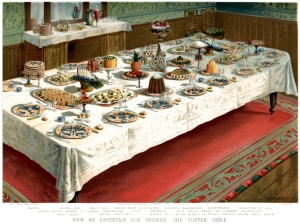As a child I had an aversion to brown wallpaper – the result, I think, of moving aged 4 1/2 into a new house previously owned by an elderly couple. It was the mid-eighties and everything was brown – some lighter, some darker, but still brown and to my mind oppressive and stuffy. As an adult, I have a similar aversion, but this time it’s beige not brown and food not furnishings. Loyal readers may recall my casual reference to this in last week’s post about Christmas parties. When my other half, loyally reading it, enquired, ‘What’s so wrong with beige food?”, I realised that to save this point – potentially central to my “food philosophy” – from the bottomless pit of obscure blog references, it required elaboration.
Let’s be clear. There is nothing intrinsically wrong with beige food. Indeed, some beige foods are entirely necessary: brown rice, quinoa, potatoes, oats, buckwheat, millet, and for the carnivorously inclined, chicken and turkey … all nutritious and useful. So with what am I taking issue? Two things. Continue reading



